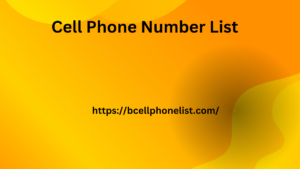Sending Texts Like a Pro: Mastering Text Messaging on Your Phone
Texting, or Short Message Service (SMS), has become an essential mode of communication for many. But with different phone models and operating systems, navigating the texting app can sometimes be confusing, especially on a new device. Fear not, fellow texter! phone types, empowering you to conquer text communication on your specific device.
Identifying Your Texting App:
The first step is to locate your phone’s built-in messaging List of saudi arabia Cell Phone Numbers application. Here are some common names you might find:
- Android: Most Android phones come pre-installed with a stock messaging app named “Messages” or a similar variant depending on the manufacturer (e.g., “Samsung Messages”).
- iPhone: iPhones use the “Messages” app for both text messages (SMS) and iMessages (messages sent between Apple devices).
If you’re unsure about your phone’s texting app, consult the user manual or search for “Messaging” on your phone.
Sending a Text Message: A Step-by-Step Guide:
Once you’ve identified your messaging app, here’s a general process for sending a text message:
- Open the Messaging App: Locate and launch the messaging app on your phone.
- Start a New Conversation: Look for a “Compose” button (often a plus sign or speech bubble icon) to initiate a new text message.
- Enter Recipient: In the “To” field, enter the phone number of the person you want to text. You can also select a contact from your phone’s address book.
- Craft Your Message: Type your message in the designated text box at the bottom of the screen. Emojis, GIFs, and pictures can often be included by tapping corresponding buttons on the keyboard.
- Send the Text: Once your message is composed, locate the “Send” button (usually an arrow icon) and tap it to deliver your text.
Note: This is a general guideline, and the specific interface elements might vary slightly depending on your phone model and operating system.
Additional Considerations:
- Network Connectivity: Ensure you have a strong cellular signal or Wi-Fi connection to send and receive text messages.
- Character Limits: Traditional SMS messages have a character limit (typically around 160 characters). If you exceed this limit, your message might be split into multiple parts, which could incur additional charges depending on your mobile plan.
- MMS vs. SMS: If you’re sending pictures or videos, you might be using Multimedia Messaging Service (MMS) instead of standard SMS. MMS messages might have different character limits and data usage charges compared to SMS.
Troubleshooting Texting Issues:
If you’re encountering problems sending text messages, here are some troubleshooting tips:
- Verify Phone Number: Double-check that the recipient’s phone number is entered correctly.
- Check Signal Strength: Ensure you have a good cellular signal or Wi-Fi connection.
- Restart Your Phone: A simple restart can sometimes resolve temporary glitches.
- Consult Your Carrier: If the issue persists, contact your mobile carrier for further assistance.
Conclusion:
Sending text messages may seem like a simple task, but understanding your phone’s messaging app and potential limitations can ensure smooth communication. By The Importance of Leading Electronics Phone Numbers following these steps and considering the additional factors, you’ll be a text-messaging pro on your phone in no time! So, fire up your messaging app, craft your message, and get ready to connect with the world, all at the touch of your fingertips.




